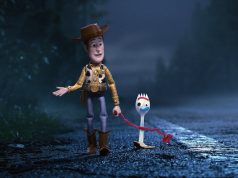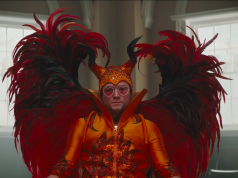Despite Walt Disney’s personal love of the film, 1940’s “Fantasia” was noteworthy mainly for its technical brilliance. As a movie, it had great music, but was otherwise not terribly interesting or amusing to watch.
One enters “Fantasia 2000” with a certain sense of trepidation, therefore, wondering if this will just be more of the same. I am pleased to report that “Fantasia 2000” is awe-inspiring, entertaining, even touching at times — all while maintaining that perfect blend between pictures and music that can almost make you weep, it’s so beautiful.
Seven new segments are shown here, along with the famous “Sorcerer’s Apprentice” segment, unchanged, from the original film. I’m glad they included it, because it confirmed for me that my recollections of “Fantasia” were accurate: cute, maybe a little magical, but nothing spectacular.
The new segments, by contrast, are stunning. First is Beethoven’s 5th Symphony set to colorful, abstract, Dorito-shaped pieces flying around like birds. There is no story line (maybe a vague connection to “good vs. evil”), but the animation is eye-catching and bold.
Respighi’s “Pines of Rome” is next, and it exemplifies the synergy between music and story better than any other segment. The story is of a family of whales that suddenly learns to fly, and the perils the baby whale encounters with this new skill. It is amazing to think the story was built to match the music, not vice versa, so perfect is the correlation between what the music makes us feel and what the pictures show us.
Another stand-out is George Gershwin’s “Rhapsody in Blue,” set to Al Herschfeld-inspired animation of several disparate Depression-era New Yorkers hoping for better lives. There’s a construction worker who wants to be a drummer; an unemployed man who wants a job; a hen-pecked husband who seeks relief; and a rich little girl who wants affection from her parents instead of being pawned off on the governess all the time.
It is genuinely touching as all these characters, separate from each other, watch the ice-skaters in Rockefeller Plaza and imagine their lives being better. Of course by segment’s end, they have gained their desires, and Gershwin’s music — one of the best compositions of any kind of the 20th century — punctuates it brilliantly.
Other pieces include Hans Christian Anderson’s “The Steadfast Tin Soldier” story set to Shostakovich’s Piano Concerto No. 2; a whimsical story about yo-yoing flamingoes accompanied by Saint-Saens’s “Carnival of the Animals”; Donald and Daisy Duck as separated lovers on Noah’s Ark while “Pomp and Circumstance” plays; and a mythical story of sprites, forests and rebirth set to Stravinsky’s “Firebird Suite – 1919 Version.”
Each segment is introduced by live-action hosts ranging from Angela Lansbury to Penn & Teller. These are mostly forgettable, except for Steve Martin, whose trademark absurdity amuses as always. (“And now here’s Itzhak Perlman,” he deadpans, “who, I’ve just been told, plays the violin.”)
This “Fantasia” has depth, humanity and soul, as well as entertainment value. It compares favorably to the more story-oriented masterpieces like “Beauty and the Beast.” View it not as an introduction to classical music (though it may be suitable for that), but as a wonderfully fulfilling movie experience.
A (; )
In 2012, I reconsidered this movie for my Re-Views column at Film.com.





